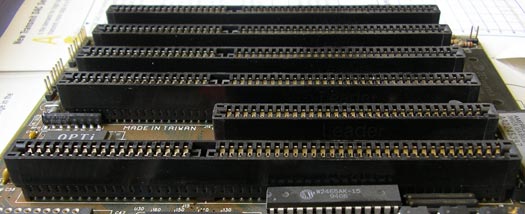nullplan wrote:bzt wrote:Well, ISA bus is not used since PCI was introduced (I mean physically, the motherboards are equivpted with different circuits and slots).
That is false. Most chipsets to this day connect their boot ROMs via something called an LPC bus
Which has absolutely nothing to do with what I've said. I repeat: "I mean
physically, the motherboards are equivpted with different circuits and slots". Since you'll never see slots like these on any motherboard manufactured in the last twenty years, means I wasn't wrong nor "false":

nullplan wrote:That's why it is called "Chipset" sometimes, because it simply integrates all of these old designs.
Then please show me a modern "chipset" that has an actual i8259A chip integrated for example. Good luck finding one.
nullplan wrote:Oh god, no. Are you talking about "legacy-free" computers? Those were a brief fad in the late nineties and early naughties. Those actually did what you are describing, but with BIOS/SMM emulation. And if the OS wanted to get at the newer hardware, it had to go through some hoops to tell the firmware to knock it off.
Oh god, yes. All modern computers use USB ports, and they are just emulating the PS2 controller (in this regard doesn't matter where the actual emulation happens, the point is, motherboards don't have PS2 controllers any more, but your software can still use the PS2 IO ports). Likewise, all i8253 chips are emulated via
HPET legacy replacement mode, there's no actual PIT chip any more.
This is usually totally transparent to the software up until the point where you want to use the latest features, in which case you must turn off the legacy emulations. For example, if you want to use HPET, then you must disable legacy replacement mode, and after that you can say bye-bye to PIT IO ports. Likewise, if you want to use LAPIC/IOAPIC, then you must turn off legacy PIC emulation (otherwise you'll experience interesting artifacts, if that even works at all).
nullplan wrote:There is no need to get BIOS to emulate the PIT via HPET
That's interesting, I'm curious how could any software (BIOS or not) emulate IO ports and IRQs, especially in real mode. It is more likely they are all emulated in hardware (in your "chipset").
nullplan wrote:Since then, mainboard manufacturers actually found the silicon necessary to put all the hardware into one chip.
And this is relevant for software how? Is this differ to my answer "there's a new hardware which emulates the old interface" in how? You're not helping the OP with this.
Cheers,
bzt



